Are Dental Implants Painful? What Patients Should Really Expect
Are Dental Implants Painful? What Patients Should Really Expect
Introduction
In this article, we will explore the common concerns and questions patients have about the pain and discomfort associated with dental implants. We aim to provide a comprehensive understanding of the dental implant process and manage patient expectations realistically. The process of getting dental implants often raises concerns, particularly regarding the associated pain.
However, understanding the procedure and preparing adequately can significantly alleviate these concerns.
It’s important for potential candidates to differentiate between discomfort and actual pain. Discomfort might be inevitable, but with modern technological advances in dentistry, pain is often minimized. Patients need to educate themselves about the pain management techniques and the role of anesthesia in the implant process.
Through this article, we provide insights that will assist patients in feeling more at ease when considering dental implants. By setting realistic expectations and offering practical advice on how to manage the post-procedure phase, we aim to ensure that the potential benefits of dental implants outweigh the concerns about discomfort and pain.
Understanding the Dental Implant Procedure
Many patients wonder what the dental implant procedure involves and how it may affect their level of pain and discomfort. Understanding the steps of the procedure can help alleviate fears and provide clarity on what to expect. Typically, the process starts with an initial consultation where the dentist evaluates your oral health and determines the suitability for implants.
The next step involves the actual placement of the implant into the jawbone, performed during a surgical procedure. This stage may sound daunting, but with modern dental techniques, it is conducted with precision and care. Most patients express surprise at how painless the procedure can be, citing more discomfort than pain.
Finally, the healing phase begins, during which the implant integrates with the jawbone. This period is crucial for the success of the implant and can last several months. It’s normal to experience mild discomfort as your body adjusts, but severe pain is uncommon. The advancements in dental procedures have made recovery smoother and more predictable for most patients.
The Role of Anesthesia and Pain Management
One of the most frequently asked questions is about the effectiveness of anesthesia and pain management during and after the dental implant procedure. This section will address the types of anesthesia used and how pain is managed to ensure patient comfort. Local anesthesia is commonly used to numb the surgical area and prevent pain during the procedure.
In some cases, conscious sedation or general anesthesia may be offered, especially for patients with dental anxiety. These methods help relax patients, ensuring a more comfortable experience without the sensation of pain. Your dentist will discuss the most appropriate option based on your specific needs and medical history.
Postoperative pain management is equally important. Dentists typically prescribe medications to help manage discomfort and prevent infection. Following the care instructions provided by your dentist, such as maintaining oral hygiene and attending follow-up visits, can effectively mitigate pain and ensure a smooth recovery.
Post-Procedure Recovery: What to Expect
This section will focus on the recovery process, including the normal levels of discomfort patients may experience after the procedure. We will discuss tips and methods to manage pain and facilitate a smooth healing process. Immediately following the surgery, it’s normal to experience some swelling and mild discomfort.
To ease this, applying ice packs to the cheek in the surgical area can reduce swelling. Over-the-counter pain relievers usually suffice for managing discomfort; however, your dentist may prescribe stronger medications if necessary. The key to a fast recovery is following all postoperative care instructions meticulously.
Maintaining a soft diet, avoiding strenuous activity, and keeping the implant site clean are fundamental to healing. It’s noteworthy that over 90% of patients report their discomfort decreases significantly within the first few days post-surgery. By the end of the recovery period, many are surprised at how minimal the pain was and are satisfied with the improved function and aesthetics of their new dental implants.
Conclusion
In conclusion, dental implants can be a beneficial solution for many patients, with pain and discomfort being manageable through proper preparation and understanding of the procedure. By addressing patient concerns and expectations, we can ensure a more positive experience with dental implants. Modern dentistry techniques have significantly reduced the pain associated with implants, making them a viable and attractive option for those needing tooth replacement.
The key to overcoming the fear of pain lies in understanding the procedure and actively engaging with your dental care provider. By doing so, patients can prepare efficiently and benefit from the corrective and aesthetic advantages that dental implants provide. Remember, the benefits often far outweigh the temporary discomfort experienced during the recovery phase.
Ultimately, dental implants represent a significant advancement in oral healthcare, restoring both function and appearance effectively. With the right guidance and patient diligence, the journey towards achieving a confident smile with the help of dental implants can be rewarding and straightforward.





Post Comment